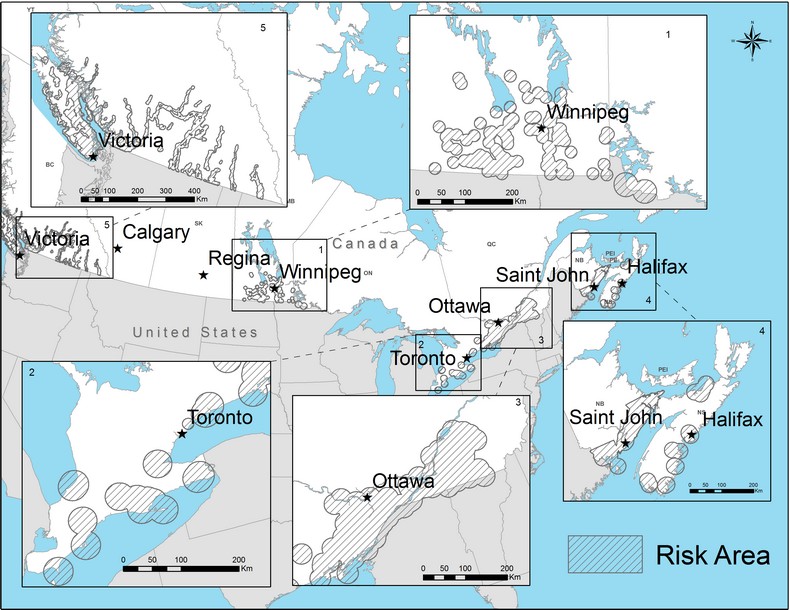There are more ticks in more parts of Canada now, experts say, and they believe that this could lead to more cases of Lyme disease this year.

“What we’re seeing is definitely a range expansion. This is not a problem that’s getting smaller, it’s tending to get larger in terms of the range of the tick,” said Robbin Lindsay, a research scientist with the Public Health Agency of Canada who specializes in ticks.
Around 20 per cent of blacklegged ticks carry the bacteria that causes Lyme disease, he said. This disease causes symptoms including fever, a rash, and fatigue. Left untreated, it can cause facial paralysis and heart and neurological disorders.
There were 1,479 cases across Canada in 2017, something PHAC calls a “significant national increase” of nearly 50 per cent since the year before.
Here’s what you need to know about ticks in 2018.
WATCH: Toronto public health officials warning about dangers of ticks

Where are they?
Blacklegged ticks are typically found in wooded areas with lots of leaf-litter, which they can hide under to escape the sun, said Curtis Russell, an entomologist with Public Health Ontario.
Although in the 1990s, they were only found on a tiny peninsula in Ontario, blacklegged ticks have since expanded their range across most provinces.
Some of the newest areas where ticks have migrated include southern New Brunswick and parts of Nova Scotia, Lindsay said.
They have spread out from Quebec’s Eastern Townships and are now found across the central and western parts of the province.

Get weekly health news
“There’s quite a bit of activity in Eastern Ontario. That area continues to really fill in,” he said. There are also some pockets in Georgian Bay and more recently, near Kenora-Rainy River.
Ticks are found “right across the southern part of Manitoba that extends from the east right over to the west. And there’s a little spot quite far north,” said Dr. Richard Rusk, medical officer of health for communicable diseases at Manitoba Health.
WATCH: As Reid Fiest reports, it no longer matters where you live in the country, ticks have no boundaries.

Manitoba’s ticks are spreading westward, said Lindsay, and are now threatening to enter Saskatchewan.
“They are currently blacklegged tick population free, but we don’t know how long it’s going to stay that way.”
A full list of Lyme disease risk areas is found on the Public Health Agency of Canada website.
It’s not just that ticks are found in more areas, he said, it’s also that there are more ticks in those areas. And, they’ve moved into more heavily-populated parts of the country.
Lyme and other diseases
That means more bites and although it can be difficult to predict year-to-year, likely more cases of Lyme disease.
“Unfortunately the trend appears to be in an upward direction. We’re definitely seeing more cases than we have historically and we’ve seen an increase on an annual basis,” Lindsay said.
There were ten times as many cases reported in 2017 compared to 2009. Numbers have increased nearly every year.

This is partly due to more ticks, but also to better detection and reporting, Rusk said. “If we are getting more cases, that means physicians are finding them. So that’s good.”
Ontario, Manitoba and the federal government have all had education programs for both the public and physicians, to help everyone better recognize the signs of Lyme disease.
WATCH: With the warmer weather upon us, ticks have come out of hibernation. Here are some of the diseases to look out for.

There are other diseases too, though. “It’s not just Lyme disease. I can’t stress this enough,” Rusk said.
Manitoba also tracks cases of anaplasmosis and babesiosis, two diseases that are much less common than Lyme. There were 15 confirmed cases of anaplasmosis in the province in 2016 and only one of babesiosis.
Prevention
The best way to prevent tick-borne disease is to not get bitten, experts say.
When you’re in a wooded area that might have ticks, stay in the middle of the trail, Russell said. The bugs can’t jump onto you, they only grab on if you brush against them.
“Wear long sleeves, light coloured clothing with everything tucked in. That way you have a better chance of noticing the tick on you,” he said. You should also wear a bug repellant containing DEET or picaridin.
When you get home, you should undress and shower to wash off any bugs that aren’t attached, and ideally get a buddy to help you check your skin for ticks. “I’ll let you define your buddy for that,” Russell said. They can be quite small – just the size of a poppy seed – so you have to check carefully.
Russell also recommends putting your clothes in the dryer for about an hour to kill any bugs on the fabric.
WATCH: Ticks and Lyme disease prevention tips

If you know that you were bitten by a tick, mark the date on your calendar, Rusk said. Manitoba actually offers a program in which, if you’re not sure whether the tick was a blacklegged tick, you can send them a photo online and they will tell you within a day or two, he said.
“If you feel that you’ve got any symptoms, you need to go to your physician,” he said. Knowing that you were bitten by a tick and when is very helpful for the doctor’s diagnosis too.
“If as a physician, you’ve got this history of this tick bite, it was eight days ago, and there’s a little bit of a rash, that’s a no-brainer. You treat. There, done.”



Comments